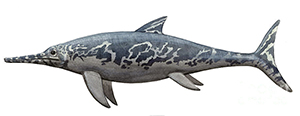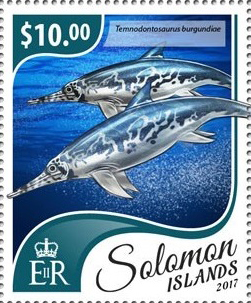Temnodontosaurus burgundiae Gaudry, 1892

(Da: www.pixels.com)
Phylum: Chordata Haeckel, 1874
Subphylum: Vertebrata Cuvier, 1812
Classe: Reptilia Laurenti, 1768
Ordine: Ichthyosauria Blainville, 1835
Famiglia: Temnodontosauridae McGowan, 1974
Genere: Temnodontosaurus Lydekker, 1889
Descrizione
Era il terzo ittiosauro più grande, 12 metri di lunghezza e 8 tonnellate di peso, dietro lo Shonisaurus 15 metri di lunghezza e 10 tonnellate di peso e lo Shastasaurus 21 metri di lunghezza e 20 tonnellate di peso. Superava le dimensioni dello Cymbospondylus lungo 10 metri e pesante 4 tonnellate. All'inizio, il Temnodontosaurus è stato classificato come Leptopterygiidae. Ma è stato rapidamente rimosso da questa famiglia in seguito alla scoperta di altre specie. Dopo essersi allontanato dai Leptopterygiidae, è stato a lungo considerato parte degli incertae sedis. Tuttavia, poiché il numero di specie di Temnodontosaurus continuava ad aumentare, Christopher McGowan creò nel 1974 una famiglia con il nome del genere: i Temnodontosauridae. Finora è l'unico genere noto alla famiglia.
Diffusione
È un genere estinto di ittiosauri del primo Giurassico, compreso tra 200 e 175 milioni di anni fa (Hettangiano - Toarciano), e conosciuto in Europa (Inghilterra, Francia, Germania e Belgio) e Cile. Vivevano nelle aree più profonde dell'oceano aperto.
Bibliografia
–Michael W. Maisch; Andreas T. Matzke (2000). "The Ichthyosauria". Stuttgarter Beiträge zur Naturkunde, Serie B. 298: 1-159.
–Christopher McGowan; Ryosuke Motani (2003). Hans-Dieter Sues (ed.). Handbook of Paleoherpetology Part 8: Ichthyopterygia. Munich: Verlag Dr. Friedrich Pfeil.
–Oliver Perry Hay (1902). Bibliography and catalogue of the fossil Vertebrata of North America. Bulletin of the United States Geological Survey. Washington: Government Printing Office. p. 462.
–Christopher McGowan (1974). "A revision of the Longipinnate Ichthyosaurs of the Lower Jurassic of England, with descriptions of two new species (Reptilia: Ichthyosauria)". Life Sciences Contributions, Royal Ontario Museum. 97: 1-37.
–Chris McGowan (1995). "Temnodontosaurus risor is a juvenile of T. platyodon (Reptilia: Ichthyosauria)". Journal of Vertebrate Paleontology. 14 (4): 472-479.
–Emily J. Swaby; Dean R. Lomax (2021). "A revision of Temnodontosaurus crassimanus (Reptilia: Ichthyosauria) from the Lower Jurassic (Toarcian) of Whitby, Yorkshire, UK". Historical Biology. 31 (11): 2715-2731.
–Antoine Laboury; Rebecca F. Bennion; Ben Thuy; Robert Weis; Valentin Fischer (2022). "Anatomy and phylogenetic relationships of Temnodontosaurus zetlandicus (Reptilia: Ichthyosauria)". Zoological Journal of the Linnean Society. 195 (1): 172-194.
–Michael W. Maisch; Axel Hungerbühler (1997). "Revision of Temnodontosaurus nuertingensis (v. Huene, 1931), a large ichthyosaur from the Lower Pliensbachian (Lower Jurassic) of Nürtingen, South Western Germany". Stuttgarter Beiträge zur Naturkunde Serie B (Geologie und Paläontologie). 248: 1-11.
–Christopher McGowan (1992). "The Sea Dragons". Dinosaurs, spitfires, and sea dragons. Cambridge: Harvard University Press. p. 246.
–Hugh Torrens (1995). "Mary Anning (1799–1847) of Lyme; 'the greatest fossilist the world ever knew'". The British Journal for the History of Science. 25 (3): 257-284.
–Deborah Cadbury (2000). "Epilogue". The Dinosaur Hunters : A True Story of Scientific Rivalry and the Discovery of the Prehistoric World. London: Fourth Estate. pp. 323-324.
–Everard Home (1814). "Some account of the fossil remains of an animal more nearly allied to fishes than any of the other classes of animals". Philosophical Transactions of the Royal Society of London. 104: 571-577.
–Everard Home (1819). "Reasons for giving the name Proteo-Saurus to the fossil skeleton which has been described". Philosophical Transactions of the Royal Society of London. 109: 212-216.
–Henry T. De la Beche; William D. Conybeare (1821). "Notice of the discovery of a new Fossil Animal, forming a link between the Ichthyosaurus and Crocodile, together with general remarks on the Osteology of the Ichthyosaurus". Transactions of the Geological Society of London. 2. 5: 559-594.
–Henry T. De la Beche (1822). "Remarks on the Geology of the South Coast of England, from Bridport Harbour, Dorset, to Babbacombe Bay, Devon". Transactions of the Geological Society of London. 2. 1 (1): 40-47.
–William D. Conybeare (1822). "Additional Notices on the Fossil Genera Ichthyosaurus and Plesiosaurus". Transactions of the Geological Society of London. 2. 1 (1): 103-123.
–Henry G. Liddell; Robert Scott (1980) [1871]. A Greek-English Lexicon (abridged ed.). Oxford: Oxford University Press.
–Richard Owen (1881). A monograph of the fossil Reptilia of the Liassic formations, Part III, Ichthyopterygia. London: Printed for the Palæontographical Society. pp. 83-134.
–Henry A. Nicholson; Richard Lydekker (1889). "Palaeozoology; Vertebrata". A manual of palaeontology for the use of students with a general introduction on the principles of palaeontology. Vol. 2. Edinburgh and London: William Blackwood and Sons. pp. 889-1464.
–Ryosuke Motani (2000). "Rulers of the Jurassic Seas". Scientific American. 283 (6): 52-59.
–Ivan R. Schwab (2002). "My, what big eyes you have . . ". The British Journal of Ophthalmology. 86 (2): 130.
–Christopher McGowan (1972). "The Distinction between Latipinnate and Longipinnate Ichthyosaurs". Life Science Contributions, Royal Ontario Museum. 20: 1-12.
–Christopher McGowan (1972). "Evolutionary Trends in Longipinnate Ichthyosaurs, with Particular Reference to the Skull and Fore Fin". Life Science Contributions, Royal Ontario Museum. 83: 1-38.
–Arthur Smith Woodward; Charles Davies Sherborn (1890). A catalogue of British fossil Vertebrata. London: Dulau & Co. p. 240.
–Nigel R. Larkin; Dean R. Lomax; Mark Evans; Emma Nicholls; Steven Dey; Ian Boomer; Philip Copestake; Paul Bown; James B. Riding; Darren Withers; Joseph Davis (2023). "Excavating the 'Rutland Sea Dragon': The largest ichthyosaur skeleton ever found in the UK (Whitby Mudstone Formation, Toarcian, Lower Jurassic)". Proceedings of the Geologists' Association. 134 (5-6): 627-640.

|
Data: 12/12/2017
Emissione: Animali preistorici acquatici Stato: Solomon Islands Nota: Emesso in un foglietto di 4 v. diversi |
|---|